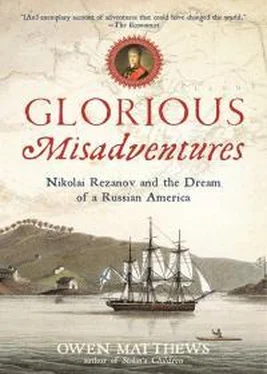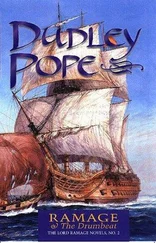The Bering–Chirikov expedition also fired imaginations in St Petersburg with dreams of adding America to the Russian Empire. ‘O, Russian Columbuses, scorning a grim Fate;/ Between the mounts of Ida will open a new path to the East;/ And we will plant our State on America’s shores,’ wrote Mikhail Lomonosov, the autodidact scientist who founded Moscow University, in his 1747 ode ‘Peter the Great’. Lomonosov, as well as being Russia’s first secular public intellectual, was also part-Pomor, a northern Russian people who had been the first explorers of the north Siberian coast. He therefore had an inherited, as well as an academic, interest in Arctic navigation. In 1755 Lomonosov penned an influential essay, ‘Letter on the Northern Route to East India via the Siberian Ocean’. He also drew the first map of the world as seen from the top, with the North Pole at its centre, showing Alaska as a natural adjunct of Siberia.30 Lomonosov suggested that a navigable north-east passage along the Arctic would open all Asia to Russian shipping.* Russia, he wrote, was now ‘an Empire on three Continents: Europe, Asia and America’.
The reality of imposing the Tsar’s laws on these vast new territories was, however, trickier than the armchair strategists of Moscow University imagined. Authority died over Siberia’s vast distances. If detached from European Russia, Siberia would still be the largest country in the world – it is bigger than the United States and Europe combined. Feudal Russia’s institutions – serfdom, aristocracy and the authority of the Church – all dissolved in the rough egalitarianism of the frontier. The self-reliant Cossacks were followed by equally independent-minded ideological exiles. First came the Old Believers, adherents of a traditional Orthodox liturgy who had been vigorously persecuted by Peter the Great’s father. They were followed by restless and ambitious peasants attracted by the freehold land they were able to own in Siberia, as well as by fugitives from justice. Like frontier America, the empty land filled with a mismatched population of God-fearing schismatics and violent criminals.31
But Siberia was not just a place of escape and new beginnings. Almost as soon as it was colonized, it also became a place of banishment and punishment. As early as the 1690s the state began to use Siberia as a dumping ground for its criminals, as though its vastness could quarantine evil.32 Katorga – from the Greek word for galley – was the judicial term for a penal settlement where inmates performed hard labour in the service of the state. The sentence was commonly imposed in place of death from the reign of Peter the Great onwards.
Under the Empress Elizabeth, who swelled the ranks of convicts by abolishing the death penalty for most offences in 1753, the crimes for which a man could be exiled included fortune-telling, vagrancy, ‘begging with false distress’, prizefighting, wife-beating, illicit tree-felling, ‘recklessly driving a cart without use of reins’ and for a brief puritanical period in the 1750s, even taking snuff.33 Until the mid-eighteenth century these exiles were always branded, usually on the face or right hand, to prevent them ever making their way back to the world. The convicts would spend up to two years shuffling in columns to their exile along the great Siberian trunk road known as the Trakt . The jingle of their chains and the ritual cries of ‘Fathers, have pity on us!’ as the condemned men held out their caps for food was, for all the travellers who passed them in their high-wheeled carriages, the sound of Siberia. By tradition at Tobolsk, 1,100 miles from Moscow, the prisoners’ leg irons were removed – a mercy, but also a sign that they had gone too far into the wilderness for escape to be survivable.
Irkutsk, founded as a Cosssack ostrog in 1652 where the Anadyr River flows into Lake Baikal, straddled the trade route between Russia and China. It soon became the entrepôt and then official capital of eastern Siberia. By 1754 there was a government school there for navigators, geodesists, mining engineers and – a sign of where the strategists of the capital were focusing their hopes for trade – translators of Japanese, taught by Japanese sailors shipwrecked on the Pacific coast of Siberia.
The combination of a vigorous outlaw culture and a thriving merchant class made Irkutsk vital and dangerous in equal measure, a place filled with turbulence and opportunity. Fur traders came from thousands of miles around after months or years in the wilderness to turn their pelts into gold and their gold into swinish pleasures. The drinking dens and gaming tables of Irkutsk were as notorious in eighteenth-century Russia as those of Deadwood would become in nineteenth-century America. The archives of the Irkutsk criminal court record at least one murder every day. The French monk and astronomer Abbé Jean Chappe d’Auteroche, sent to Siberia by Catherine the Great to observe the passage of the moons of Jupiter in 1770, reported that the clergy were so drunk and libidinous that priests were ‘often found in the streets unable to walk home’.34
Cut off from European Russia like the French of Quebec or the British of Bermuda, the merchants of Irkutsk preserved a language and dress considered antiquated even by the late eighteenth century. The Mongol belted kaftan, abandoned in the capital under Peter, was worn in Irkutsk into the twentieth century. Merchant money built grand mansions along boulevards lined with pine-plank boardwalks against the mud, but the backstreets stank, reported Auteroche, with pigs feeding in the open sewers.35
Government postings in Siberia attracted the desperately ambitious or the desperately disgraced. The tone was set by Matvei Gagarin, Peter the Great’s appointee as governor of Tobolsk, in western Siberia. Early in his nine-year reign the wilderness called to something greedy and vicious in Gagarin. He began minting his own coinage and made such a fortune from smuggling that he shod his horse with silver and dispensed his own justice, ordering arsonists burned alive. Peter had his wayward lieutenant brought back to the capital in chains and hanged. The Tsar ordered that Gagarin’s body remain on the gibbet as an example to others. When the rope around the corpse’s neck rotted Peter had it replaced by a chain.
Yet even such drastic punishments did little to improve Siberia’s notoriously corrupt, rapacious and brutal government officials. ‘Written laws should not be treated like playing cards,’ stormed Peter in a decree of 1723. ‘This ukaz seals all orders and regulation like a stamp so that nobody can act according to their own whims or in breach of instructions.’ But repeated laws to protect natives against extortion, abuse, sex slavery and being deprived of their hunting grounds are clear evidence that previous laws to that effect had been ignored.
Pyotr Rezanov must have viewed the prospect of a job in this barely-civilized outpost of the empire with trepidation. But he knew that if he was lucky and clever the post promised lucrative possibilities for patronage and self-enrichment. As an aristocrat he required no legal qualifications to become a judge, and this was the post he sought and received. In spring 1769 Rezanov left his wife and young children in St Petersburg and set off to dispense justice in the wilderness. The foundations of a long and lucrative – for his son, if not for him – family connection to Russia’s wild east had been laid.
Footnotes
* A similar rule regarding converts to Islam applied in the contemporary Ottoman empire, which was at the time powering through the Balkans.
* Pace John Keats; not ‘stout Cortez’.
* The natives commemorated the disaster in petroglyphs found nearby, which appear to show a sailing ship and boats.
Читать дальше












